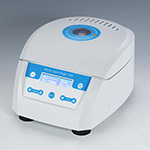Microcentrifuge Definition: A microcentrifuge is a special type of centrifuge. It performs the function of centrifuging samples in small capillaries in order to separate the components of these samples into two phases.
What is a microcentrifuge used for?
A microcentrifuge is an essential piece of equipment in any laboratory. Because it is used to spin various samples at high speed. For example, nucleic acids or proteins can be precipitated from solution, small water samples can be microfiltered and the liquid collected at the bottom of the tube to avoid waste. Equipped with a microcentrifuge in your lab, your samples can be spun evenly without a technician nearby. Duplicate samples can be handled in the same way. Many technicians can introduce your samples into the machine, but their handling will remain the same.
Tubes used in microcentrifuges can vary from 0.2 ml to 5 ml. There are several types of microcentrifuges, the most common being high-speed microcentrifuges and refrigerated high-speed microcentrifuges.
High-speed microcentrifuges are mainly used in the fields of hematology, biology, agriculture, biotechnology, microbiology, biochemistry, microchemistry, hepatology, immunology, clinical chemistry, endocrinology, pharmacology and toxicology.
You might want to read: how to use a microcentrifuge (wikipedia) lifepo4
Centrifuge vs Microcentrifuge
These microcentrifuges work the same way as traditional centrifuges, they just differ in size. And both are capable of separating mixtures of solid and liquid elements of varying densities. Depending on the sample, expose them to a rotational force of the desired intensity.
When using a microcentrifuge, it must be taken into account that loads with the same mass or weight must be located opposite the rotor, in addition to that they must have the same center of gravity.
How to choose the right microcentrifuge for your laboratory?
There are several models of microcentrifuges on the market. A microcentrifuge is certainly a long-term investment, so there are some key questions to ask yourself when you’re choosing how to spend your money.
1. What is the scope of application of your new microcentrifuge?
What g-force and material volume are you studying? You also need to consider how many people will be using microcentrifuges, how many microcentrifuges will be used each day and in what environment. Finally, how much budget do you have to buy a microcentrifuge?
2. Is your chosen model safe enough?
The working force of the microcentrifuge is relatively high. So check out the security features it offers you. Important safety features to consider when purchasing a microcentrifuge include whether the machine will operate if the sample is not carefully dispensed to provide optimal balance. Does the machine have a cover to protect the technician from a tube that breaks during centrifugation. Does the lid remain locked until the procedure is complete? At what temperature and humidity conditions are microcentrifuges safe to operate?
These are the basic questions to consider when choosing a microcentrifuge for your laboratory. Now let’s look at the options!
We offer two microcentrifuge recommendations for your laboratory.
KETHINK offers you a wide range of microcentrifuges to choose from. They are all great value for money and perform different lab functions.
KETHINK 16000 rpm and 6000 rpm microcentrifuges
KETHINK Microcentrifuge 6000-16000rpm models feature the usual brushless DC motors found in all benchtop laboratory equipment. This means they are all very quiet, producing no more than 60 decibels of noise. And can run for a long time with very little maintenance. On these microcentrifuge models, vertical adapters for accommodating 0.2mL and 0.4mL microtubes can be easily installed.
If any sample is spilled, it should be cleaned up immediately to protect the integrity of the device, and the rotor can be easily removed and removed using the Allen key provided with the device.
KETHINK microcentrifuges are easy to program. And with a large, easy-to-read display, ideal for viewing from across the room while you focus on other tasks in the lab to get the most out of your work.
KETHIN microcentrifuges can all be run inside a fume hood or in a cold room and operate at temperatures up to 40°C and 80% humidity. They are also firmly attached to the workbench and retain their position even during operation.
Finally:what considerations should you keep in mind when it comes to microcentrifuges?
Loading the microcentrifuge in the correct way is very important for its proper operation and storage. Incorrect loading procedures can cause the centrifuge to vibrate during centrifugation. This results in damage to the rotor, possibly leading to its replacement.
Proper loading procedure involves placing the load on the rotor in a balanced manner. Centrifuges are designed for balance while in motion. For this, the following requirements must be met:
- Position the loads so that loads of the same mass or weight are placed on the rotor opposite each other. If you are loading an odd number of samples, look for another sample of the same weight so that opposite pairs of the same weight are always formed. Never put an odd number of samples into the centrifuge.
- In addition to having the same mass (weight), they must also have the same center of gravity, ie: do not place the tube and container as opposite pairs, they have different shapes, sizes and thicknesses.
- Use the centrifuge by placing all accessories on the rotor, as the device is designed to be used with these accessories.
- Use original equipment rotors and accessories. Non-original parts can create imbalances and shorten the life of the equipment.

